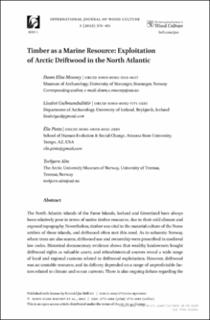| dc.contributor.author | Mooney, Dawn Elise | |
| dc.contributor.author | Guðmundsdóttir, Lísabet | |
| dc.contributor.author | Pinta, Élie | |
| dc.contributor.author | Alm, Torbjørn | |
| dc.date.accessioned | 2023-07-18T08:52:48Z | |
| dc.date.available | 2023-07-18T08:52:48Z | |
| dc.date.created | 2023-03-14T10:17:05Z | |
| dc.date.issued | 2023-03 | |
| dc.identifier.citation | Mooney, E.D., Guðmundsdóttir, L., Pinta, E., Alm, T. (2023) Timber as a Marine Resource: Exploitation of Arctic Driftwood in the North Atlantic. International Journal of Wood Culture | en_US |
| dc.identifier.issn | 2772-3186 | |
| dc.identifier.uri | https://hdl.handle.net/11250/3079683 | |
| dc.description.abstract | The North Atlantic islands of the Faroe Islands, Iceland and Greenland have always been relatively poor in terms of native timber resources, due to their cold climate and exposed topography. Nevertheless, timber was vital to the material culture of the Norse settlers of these islands, and driftwood often met this need. As in subarctic Norway, where trees are also scarce, driftwood use and ownership were prescribed in medieval law codes. Historical documentary evidence shows that wealthy landowners bought driftwood rights as valuable assets, and ethnohistorical sources reveal a wide range of local and regional customs related to driftwood exploitation. However, driftwood was an unstable resource, and its delivery depended on a range of unpredictable factors related to climate and ocean currents. There is also ongoing debate regarding the relative importance of imported timber, which is for example often referenced in the Icelandic sagas. The use of driftwood is difficult to demonstrate through macroscopic, microscopic, or (geo-)chemical analysis. Similarities in the microscopic anatomy of boreal wood taxa preclude definitive provenancing through taxonomic analysis, and material traces of immersion in seawater are often either impermanent or ambiguous, especially in archaeological wood remains. This paper presents a comprehensive review of current historical and archaeological research on the exploitation of driftwood timber in the Medieval North Atlantic and explores potential future directions in this field. Furthermore, it asserts that this line of research should be pursued with some urgency, as anthropogenic climate change threatens both driftwood delivery and the preservation of archaeological wood remains. | en_US |
| dc.language.iso | eng | en_US |
| dc.publisher | Brill | en_US |
| dc.relation.uri | https://brill.com/view/journals/ijwc/aop/article-10.1163-27723194-bja10021/article-10.1163-27723194-bja10021.xml | |
| dc.rights | Navngivelse 4.0 Internasjonal | * |
| dc.rights.uri | http://creativecommons.org/licenses/by/4.0/deed.no | * |
| dc.subject | arkeologi | en_US |
| dc.subject | båtbygging | en_US |
| dc.subject | Nord-Atlanteren | en_US |
| dc.subject | historie | en_US |
| dc.subject | sagalitteratur | en_US |
| dc.subject | drivved | en_US |
| dc.title | Timber as a Marine Resource: Exploitation of Arctic Driftwood in the North Atlantic | en_US |
| dc.type | Peer reviewed | en_US |
| dc.type | Journal article | en_US |
| dc.description.version | publishedVersion | en_US |
| dc.rights.holder | © Dawn Elise Mooney et al., 2023 | en_US |
| dc.subject.nsi | VDP::Humaniora: 000::Arkeologi: 090::Nordisk arkeologi: 091 | en_US |
| dc.source.journal | International Journal of Wood Culture (IJWC) | en_US |
| dc.identifier.doi | 10.1163/27723194-bja10021 | |
| dc.identifier.cristin | 2133705 | |
| dc.relation.project | Universitetet i Stavanger: IN-12564-03 | en_US |
| cristin.ispublished | true | |
| cristin.fulltext | original | |
| cristin.qualitycode | 1 | |

